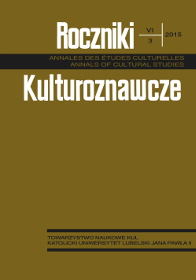Jerusalem in the Traditions of Muslim Culture
Abstract
For Muslims, Jerusalem is the third holiest site, after Mecca and Medina. The Holy City marks the continuity that exists between the religions, and emphasizes the unity of the revelation of God in human history. Just like for the Jews and the Christians, also for the Muslims, Jerusalem is the center of the world. Compared with the previous religions, however, Jerusalem has become a symbol of the superiority of Islam, as a perfect religion that will lead humanity to the Last Day.
The Muslim culture developed a rich symbolism associated with Jerusalem. Muhammad, who historically never reached the Holy City, accomplished this journey in a mystical way. Here he met with former prophets and ascended to heaven to meet God himself. The goal of this event was to confirm his mission as the last and perfect prophet.
The Muslim architecture shows the role of Jerusalem in Islamic culture. It emphasizes the historical connection of Islam with previous religious traditions, it points to the eschatological events and the final meeting of humanity with God, which will be in the Holy City at the End of Time.
References
Abdullah Yusuf Ali: The Meaning of the Holy Qur’an. Beltsville, MD: Amana Publications 2008.
Amstrong Karen: Jerozolima. Miasto trzech religii. Tłum. Barbara Cendrowska.Warszawa: VIK 2010.
Center for Muslim-Jewish Engagement. http://www.usc.edu/org/cmje/religious-texts/hadith/ [dostęp 24.06.2015].
Déroche François: Jérusalem. W: Dictionnaire du Coran. Sous la direction de Mohammad Ali Amir-Moezzi. Paris: Robert Lafont 2007 s. 437-438.
Do Ziemi Świętej. Najstarsze opisy pielgrzymek do Ziemi Świętej IV-VIII w. Wybór, wstęp, wprowadzenia i opracowanie Piotr Iwaszkiewicz. Przedmowa ks. Marek Starowieyski. Kraków: Wydawnictwo WAM 2010
Ettinghausen Richard, Grabar Oleg, Jenkins-Madina Marilyn: Sztuka i architektura islamu 650-1250. Tłum. Jolanta Kozłowska, Ivonna Nowicka, Katarzyna Pachniak. Warszawa: Wydawnictwo Akademickie Dialog 2007.
Geoffroy Éric: Ascension céleste. W: Dictionnaire du Coran. Sous la direction de Mohammad Ali Amir-Moezzi. Paris: Robert Lafont 2007 s. 95-99.
Gilchrist John: Muhammad and the Religion of Islam: Al-Mi’raj: The Alleged Ascent to Heaven. http://answering-islam.org/Gilchrist/Vol1/3d.html [dostęp 25.06.2015].
Gnilka Joachim: Koran i chrześcijanie. Tłum. Monika Waluś. Kielce: Jedność 2010.
Guillaume Alfred: The Life of Muhammad. The Translation of Isḥāq’s Sīrat Rasūl Allāh with introduction and notes by A. Guillaume. Oxford University Press 2004.
Hattstein Markus, Delius Peter: Islam. Historia, sztuka, architektura. Tłum. Janusz Danecki, Krystyna Schmidt. Warszawa: Buchman 2012.
Kalayan H. The Similarity in Planning the Dome of the Rock and the Church of Ascension in Jerusalem. W: „Annual of the Department of Antiquities of Jordan” 26:1982 s. 405-409.
Koran. Tłum. Józef Bielawski. Warszawa: PIW 1986.
Muir William: The Life of Mahomet. Vol. 2. London: Smith, Elder and Co. 1861.
Murphy-O’Connor Jerome: Przewodnik po Ziemi Świętej. Tłum. Mariusz Burdajewicz. Warszawa: Oficyna Wydawnicza „Vocatio” 1996.
Pringle Denys: The Churches of the Crusader Kingdom of Jerusalem. Vol. 3: The City of Jerusalem. Cambridge: Cambridge University Press 2007.
Sahih al-Bukhari. W: Sunna.com – http://sunnah.com [dostęp 24.06.2015].
Sahih Muslim. W: Sunna.com – http://sunnah.com [dostęp 24.06.2015].
Sebag Montefiore Simon: Jerozolima. Biografia. Tłum. Maciej Antosiewicz i Władysław Jeżewski.Warszawa: Wydawnictwo Magnum 2011.
Snaczke Gabriela, Szuro Stanisław: Jerozolima. W: Miejsca święte. Warszawa: Medioprofit 2010.
Tafsir al-Jalalayn. W: The Tafsirs. http://www.altafsir.com [dostęp 25.06.2015].
Tafsir ibn Kathir. http://www.qtafsir.com [dostęp 24.06.2015].
The Arabic Islamic Inscriptions On The Dome Of The Rock In Jerusalem, 72 AH / 692 CE. http://www.islamic-awareness.org/History/Islam/Inscriptions/DoTR.html [dostęp 24.06.2015].
The Night Journey of Sura 17. http://www.muslimhope.com/NightJourney.htm [dostęp 24.06. 2015].





